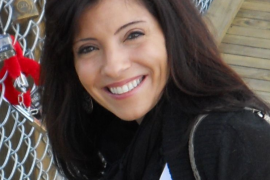Merchandise at your favorite store doesn’t magically appear on the store shelves. In fact, there’s a lot of planning that goes into the number and types of candy bars that fill checkout-line racks. And that’s where Jennifer Cassara comes in. As a retail buyer, she helps stores decide which (and how many) products are sold in stores. And — surprise! — there’s math involved.
Can you explain what you do for a living?
I have a very cool job. I am a retail buyer. This means that I select and purchase merchandise that will be sold in the stores that I work for. I get to travel to trade shows, review catalogs and meet with manufacturers to look at different products in order to decide what to order. I have bought almost every different type of product — clothing, gifts and even candy! In fact, I strongly suggest going to the candy trade show; it’s delicious! And while this sounds like a lot of fun, the decisions I make have a strong impact on the success of my company. In order to make the correct selections, I need to base my decisions on multiple factors including price, function, visual appeal, gross margin/profitability and the sales history of similar products (not just because I like it). I rely a lot on math to help me with this analysis.
When do you use basic math in your job?
I use basic math all of the time. I use addition, subtraction, multiplication and division daily to understand how products and product classifications are selling. Right now, owls and cupcakes are two hot trends. Every week I look at how many owl and cupcake products have sold and I calculate which of these products are selling the best. Once I have identified the best products, I need to decide if I have enough to achieve my sales plan or if I need to order more. I do this by looking at the average number of units we are selling in a week and I project out how many I will need for a specific amount of time. For example, if I want to keep this product for 8 weeks and I am selling 100 a week, I know that I need a total of 800 units. If I only have 200 units in inventory then I know that I need to order 600 more. If I order too little, I don’t make my sales plan and if I order too many, I may need to mark them down.
Do you use any technology to help with this math?
Although I use basic math, many of the calculations are too difficult to do in my head so I depend a lot on calculators and computers to help me. I never go anywhere without my calculator. Seriously. One of the calculations I am always running is markup percentage. The markup of an item is the percentage of sales of that item that is profit. The higher the markup percentage, the greater the profit. When I am at a trade show and I am negotiating a price, I need to be able to calculate what the markup of the item will be – quickly. This is why I always carry my calculator. If the markup is not high enough, I need to negotiate for a better price, and I need to know what the ideal price is on the spot.
How do you think math helps you do your job better?
It would be impossible to do my job without math. When I first started in the Lord & Taylorretail training program, the first class they gave us was in retail math. They showed us how to apply simple math equations to sales data in order to make sense of it. Today, I use retail math to look at sell-through to see which styles are selling the most rapidly. I also compare the percentage of a product we have on hand to the percentage of sales it produces to understand which products have the greatest impact on sales. I try to find commonalities across my best-selling styles to help identify trends. Once I know that something is trending, I can buy into with confidence. Math enables me to make better buying decisions because I am able to analyze sales more effectively. The better I am at understanding what is selling and why, the better I am at selecting what styles will sell best in the future.
How comfortable with math do you feel?
I am actually very comfortable with math. In school I was definitely what you would call a “math geek,” but there are many buyers who never had any confidence with math at all. Since the calculations we use are relatively simple and we repeat them often, buyers quickly learn to master them and rely on them to make sense of their inventory. It’s always exciting to review selling each week and to see what the best-selling styles are. We are always looking for the next new thing. I remember when Smencils (scented pencils) first hit the stores. I could tell in the first week of sales that this was going to be a trend. Boy did we sell a lot of scented pencils!
Does this math feel different to you?
Even though I am usually confident with my math skills, there is definitely a greater comfort in the math I use everyday. It is much easier for me than a lot of the more complicated equations we used to do in school — thankfully! This is because I understand each component of the equations I am performing. I know how to best use them to get the answers I am looking for. For me, it’s no longer just about memorizing a calculation.
What kind of math did you take in high school?
I took trigonometry, computer science and AP calculus in high school. Like I said, I’m kind of a math geek. It didn’t all come easy to me, though, and some classes were more enjoyable than others. For some reason, I really liked calculus. I had a great teacher and I loved the challenge of solving a difficult equation. It really felt like I had accomplished something when I got the right answer. This is similar to the accomplishment I feel today when I buy a great seller or discover a hot trend. It’s the most exciting part of my job.
Did you have to learn new skills in order to do this math?
The retail math itself was easy to pick up from the skills I had learned in school, but what I really needed to learn was how to apply the right equations to best analyze the information I was looking at. Sometimes it’s really hard to understand what the numbers are telling you. Do I look at sell-through, sales as a percent to total, gross margin or the variance to last year? Maybe it’s all of the above. It’s my job to find the best way to make sense of the numbers.
Anything else you want to mention?
A couple of years ago, my company converted to a new retail software system. For the buyers, it was like starting over. We didn’t have the same old reports to rely on and noone was able to navigate through the new system to create the reports we needed. This is when the computer science skills I had learned in school came in handy. I dug in and spent many hours of trial and error to try to create the new reports that the buyers needed. My hard work paid off. Today, every report that the buyers use was created by me. I feel a tremendous sense of satisfaction knowing that I was able to use my math skills to help move my company forward. They allowed me to turn a difficult situation into a rewarding experience.
Thanks so much to Jennifer for giving us a peek into the mysterious world of retail buying. If you have questions for Jennifer, be sure to ask them in the comments section!


